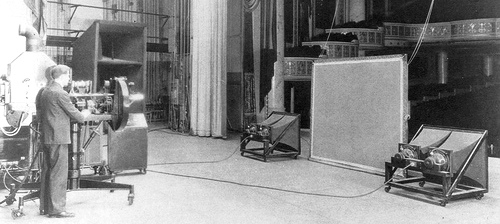Albert, a mirror wheel like that was also used in a French public Television projector, using a lightvalve as lightsource. Must search for the name, and source as i saw the reference years ago. Machine was from 1936 it said.
Edit: Scophony https://en.wikipedia.org/wiki/Scophony, UK/Germany http://www.earlytelevision.org/scophony_projection_tv.html http://www.earlytelevision.org/pdf/pop_sci_7-49.pdf
Small projector:



The Schlierenstop made a return in the GLV laser projectors, most notably the ESLP.

GE mechanical projection demo 1930, above, others doing the same that year: http://www.sportsvideo.org/blogs/?blog=schubin-cafe&news=getting-the-big-picture, others: http://www.earlytelevision.org/mechanical_theater_tv.html
Edit: Scophony https://en.wikipedia.org/wiki/Scophony, UK/Germany http://www.earlytelevision.org/scophony_projection_tv.html http://www.earlytelevision.org/pdf/pop_sci_7-49.pdf
Small projector:


The Schlierenstop made a return in the GLV laser projectors, most notably the ESLP.

GE mechanical projection demo 1930, above, others doing the same that year: http://www.sportsvideo.org/blogs/?blog=schubin-cafe&news=getting-the-big-picture, others: http://www.earlytelevision.org/mechanical_theater_tv.html

Comment